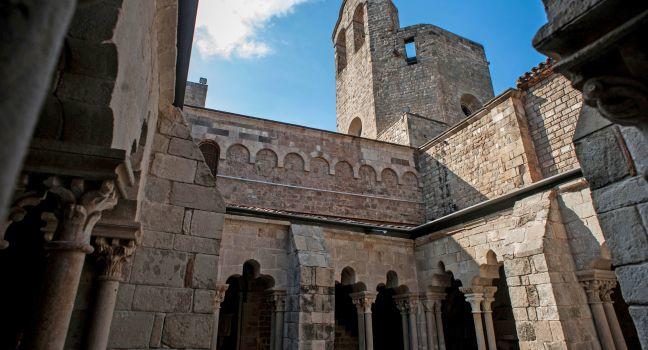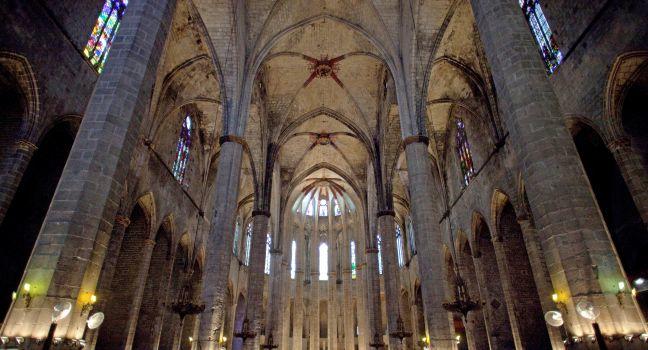La Catedral de Barcelona
Barcelona's cathedral is a repository of centuries of the city's history and legend—although as a work of architecture visitors might find it a bit of a disappointment, compared to the Mediterranean Gothic Santa Maria del Mar and Gaudí's Moderniste Sagrada Família. It was built between 1298 and 1450; work on the spire and neo-Gothic facade began in 1892 and was not completed until 1913. Historians are not sure about the identity of the architect: one name often proposed is Jaume Fabre, a native of Mallorca. The building is perhaps most impressive at night, floodlit with the stained-glass windows illuminated from inside; book a room with a balcony at the Hotel Colon, facing the cathedral square, and make the most of it.
This is reputedly the darkest of all the world's great cathedrals—even at high noon the nave is enveloped in shadows, which give the appearance that it's larger than it actually is—so it takes a while for your eyes to adjust to the rich, velvety pitch of the interior. Don't miss the beautifully carved choir stalls of the Knights of the Golden Fleece; the intricately and elaborately sculpted organ loft over the door out to Plaça Sant Iu (with its celebrated Saracen's Head sculpture); the series of 60-odd wood sculptures of evangelical figures along the exterior lateral walls of the choir; the cloister with its fountain and geese in the pond; and, in the crypt, the tomb of Santa Eulàlia.
St. Eulàlia, originally interred at Santa Maria del Mar—then known as Santa Maria de les Arenes (St. Mary of the Sands)—was moved to the cathedral in 1339, and venerated here as its patron and protector. Eulalistas (St. Eulàlia devotees, rivals of a sort to the followers of La Mercé, or Our Lady of Mercy) celebrate the fiesta of La Laia (the nickname for Eulàlia) for a few days around her feast day on February 12.
Enter from the front portal (there are also entrances through the cloister and from Carrer Comtes down the left side of the apse), and the first thing you see are the high-relief sculptures of the story of St. Eulàlia, on the near side of the choir stalls. The first scene, on the left, shows St. Eulàlia in front of Roman Consul Decius with her left hand on her heart and her outstretched right hand pointing at a cross in the distance. In the next, she is tied to a column and being whipped by the consul's thugs. To the right of the door into the choir the unconscious Eulàlia is being hauled away, and in the final scene on the right she is being lashed to the X-shape cross upon which she was crucified in mid-February in the year 303. To the right of this high relief is a sculpture of the martyred heroine, resurrected as a living saint.
Among the two dozen ornate and gilded chapels in the basilica, pay due attention to the Capella de Lepant, dedicated to Sant Crist de Lepanto, in the far right corner as you enter through the front door. According to legend, the 15th-century polychrome wood sculpture of a battle-scarred, dark-skinned Christ, visible on the altar of this 100-seat chapel behind a black-clad Mare de Deu dels Dolors (Our Lady of the Sorrows), was the bowsprit of the flagship Spanish galley at the battle fought between Christian and Ottoman fleets on October 7, 1571.
Outside the main nave of the cathedral to the right, you'll find the leafy, palm tree–shaded cloister surrounding a tropical garden and a pool said to be populated by 13 snow-white geese, one for each of the tortures inflicted upon St. Eulàlia in an effort to break her faith. Legend has it that they are descendants of the flock of geese from Rome's Capitoline Hill, whose honking alarms roused the city to repel invaders during the days of the Roman Republic. Don't miss the fountain with the bronze sculpture of an equestrian St. George, hacking away at his perennial foe, the dragon, on the eastern corner of the cloister. On the day of Corpus Christi, this fountain is one of the more spectacular displays of the traditional l'ou com balla (dancing egg).
In front of the cathedral is the grand square of Plaça de la Seu, where on occasion, barcelonins gather to dance the sardana, the circular folk dance performed for centuries as a symbol-in-motion of Catalan identity and the solidarity of the Catalan people. Nimble-footed oldsters share the space with young esbarts (dance troupes), coats and bags piled in the center of the ring, all dancing together to the reedy music of the cobla (band) in smooth, deceptively simple, heel-and-toe sequences of steps. This is no tourist attraction: Catalans dance the sardana just for themselves. Check local listings for the annual series of evening organ concerts held in the cathedral.





